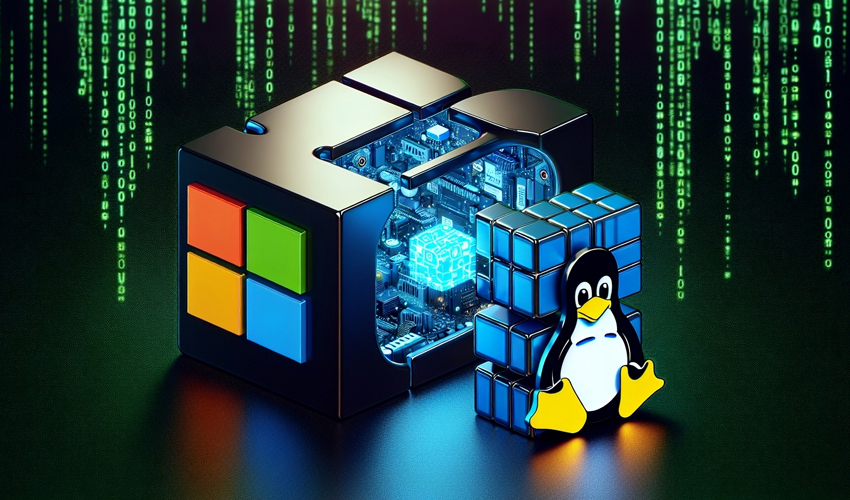Linux

Linux has always been more than just a kernel, it’s a living, breathing world of innovation, community collaboration, and divergent use cases. As we roll into 2026, the landscape is poised for exciting growth. From continuing evolution of core kernel infrastructure to newfound momentum in areas like gaming, AI-augmented tooling, hardware support and security, the coming year promises both refinement and transformation. Whether you’re a developer, system administrator, gamer, or casual user, here’s what you can expect from the Linux world in 2026.
1. Kernel Evolution: Performance, Security, and AI-Driven Behavior
The Linux kernel remains the beating heart of the OS. In 2026, we’ll likely see:
-
New Long-Term Support (LTS) Baselines: With releases like 6.18 already declared LTS and successor branches maturing, distributions will rally around kernels that offer both performance gains and security longevity.
-
AI-Driven Infrastructure: Kernel subsystems may start experimenting with machine-learning-informed scheduling, resource management, or dynamic power/performance tuning, not via heavy inference at runtime, but via control-plane advice integrated at build or boot time.
-
Security Innovation: Hardware vulnerabilities like VMScape and speculative execution side channels have taught us that kernel mitigations remain crucial. Expect continued work on microarchitecture hardening, pointer tagging, and improved isolation.
The overall trend points to a kernel that is both more performant and more robust, without compromising the modularity that makes Linux adaptable across systems from supercomputers to handhelds.
2. The Desktop Experience: Polished, Consistent, and Accessible
For desktop users, 2026 should bring visible improvements to everyday workflows:
-
Wayland Maturity: Wayland adoption continues to solidify across distributions, with fewer fallbacks to legacy X11 backends. Compositors and toolkits will refine scaling, multi-monitor behavior, and screen capture APIs.
-
Accessibility Gains: Distros will invest more in accessibility, bringing improved screen reader support, better keyboard navigation, and wide internationalization.
-
Distribution Diversity: More polished newcomers and revitalizations of existing distros will continue, especially projects aimed at lowering the barrier to entry for users migrating from Windows or macOS.
The promise here is a Linux desktop that feels friendly without diluting depth for advanced customization.
3. Cloud, Edge, and Server Infrastructure: Linux Everywhere
Linux powers the backbone of the modern server and cloud world. In 2026:

Introduction
Linux has long been known as the operating system of developers and power users, but today it’s far more accessible than ever before. Thanks to user-friendly distributions that prioritize simplicity, stability, and support, even someone who’s never used Linux can get up and running quickly. In this guide, we’ll explore some of the best Linux distributions (distros) for beginners, what sets them apart, and who each one is best suited for.
Whether you’re switching from Windows or macOS, using a PC for the first time, or simply curious about Linux, there’s a distro here that fits your comfort level and workflow.
1. Ubuntu: The Standard for New Users
Why it’s great: Ubuntu is one of the most recognizable Linux distributions, and for good reason. It offers a polished graphical interface, a massive community, and extensive documentation. If you’ve ever wanted a desktop that “just works,” Ubuntu delivers with minimal setup.
Key Features:
-
Intuitive GNOME desktop environment
-
Regular releases and a Long-Term Support (LTS) version with five years of updates
-
Large software repository and excellent hardware support
-
Strong community forums and extensive official documentation
Good for: Users completely new to Linux or those switching from Windows or macOS.
Best for: Desktops, laptops, beginners.
2. Linux Mint: Familiar Feel for Former Windows Users
Why it’s great: Linux Mint focuses on a familiar desktop experience. Its Cinnamon edition resembles the classic Windows layout, making the transition easier for users coming from that platform. Mint is stable, fast, and comes with many tools that simplify daily tasks.
Key Features:
-
Traditional desktop layout (like Windows)
-
Comes bundled with multimedia codecs and essential apps
-
Excellent performance on older hardware
-
Multiple desktop options (Cinnamon, MATE, Xfce)
Good for: Windows switchers looking for a gentle introduction.
Best for: Desktops, older machines, learners.
3. Zorin OS: A Windows-Like Experience With Style
Why it’s great: Zorin OS is designed with newcomers in mind. It’s polished, modern, and “comfortable” for users who may find traditional Linux desktops intimidating. Its interface can mimic Windows or macOS out of the box, and Zorin includes tools to effortlessly install popular applications.
Key Features:
-
Look-and-feel switcher (Windows, macOS styles)

Introduction
The KDE community has just published KDE Gear 25.12, the newest quarterly update to its suite of applications. This refresh brings a mix of enhancements, bug fixes, performance refinements, and new features across many popular KDE apps, from Dolphin file manager and Konsole terminal to Krita and Spectacle. With this release, KDE continues its tradition of incremental yet meaningful upgrades that make everyday use smoother and more productive.
KDE Gear updates are not limited to the KDE Plasma desktop; they also benefit users of other desktop environments who install KDE apps on their systems. Whether you’re running KDE on Linux, BSD, or even Windows via KDE Windows builds, Gear 25.12 delivers improvements worth checking out.
Highlights from KDE Gear 25.12
Dolphin: Better File Browsing and ThumbnailsDolphin, KDE’s file manager, receives several enhancements in this update:
-
Improved thumbnail generation for more file types, making previews quicker and more dependable.
-
UI polish in the sidebar for easier navigation between folders and mounted drives.
-
Better handling of network shares and remote locations, improving responsiveness and reducing hangs.
These changes combine to make everyday file exploration more responsive and visually informative.
Konsole: Productivity BoostsThe KDE terminal emulator, Konsole, gets attention too:
-
Search field improvements help you find text within long terminal scrollbacks faster and with fewer clicks.
-
Tab and session indicators are clearer, helping users manage multiple tabs or split views more easily.
-
Stability fixes reduce crashes in edge cases when closing multiple sessions at once.
For developers and power users who spend a lot of time in a terminal, these refinements are genuinely useful.
Krita: More Painting PowerKrita, KDE’s professional painting and illustration application, also benefits from this release:
-
Improvements to brush performance, reducing lag on large canvases and complex brush sets.
-
Better color management and palette handling, smoothing workflows for digital artists.
-
Fixes for certain configuration edge cases that previously caused settings not to persist across sessions.
Artists and digital illustrators should notice fewer interruptions and smoother performance when working on large projects.

One of the most widely deployed Linux kernels has officially reached the end of its lifecycle. The maintainers of the Linux kernel have confirmed that Linux 5.4, once a cornerstone of countless servers, desktops, and embedded devices, is now end-of-life (EOL). After years of long-term support, the branch has been retired and will no longer receive upstream fixes or security updates.
A Kernel Release That Defined a Generation of Linux Systems
When Linux 5.4 debuted, it made headlines for bringing native exFAT support, broader hardware compatibility, and performance improvements that many distributions quickly embraced. It became the foundation for major OS releases, including Ubuntu LTS, certain ChromeOS versions, Android kernels, and numerous appliance and IoT devices.
Its long support window made it a favorite for organizations seeking stability over bleeding-edge features.
What End-of-Life Actually Means
With the EOL announcement, the upstream kernel maintainers are officially done with version 5.4. That means:
-
No more security patches
-
No more bug fixes or performance updates
-
No regressions or vulnerabilities will be addressed
Some enterprise vendors may continue backporting patches privately, but the public upstream branch is now frozen. For most users, that makes 5.4 effectively unsafe to run.
Why This Matters for Users and Organizations
Many devices, especially embedded systems, tend to run kernels for much longer than desktops or servers. If those systems continue using 5.4, they now risk exposure to unpatched vulnerabilities.
Running an unsupported kernel can also create compliance issues for companies operating under strict security guidelines or certifications. Even home users running older LTS distributions may unknowingly remain on a kernel that’s no longer protected.
Upgrading Is the Clear Next Step
With 5.4 retired, users should begin planning an upgrade to a supported kernel line. Today’s active long-term support kernels include more modern branches such as 6.1, 6.6, and 6.8, which provide:
-
Better CPU and GPU support
-
Significant security improvements
-
Enhanced performance and energy efficiency
-
Longer future support windows
Before upgrading, organizations should test workloads, custom drivers, and hardware, especially with specialized or embedded deployments.

For years, Windows users frustrated with constant changes, aggressive updates, and growing system bloat have flirted with switching to Linux. But 2025 marks a noticeable shift: a new generation of Linux distributions built specifically for ex-Windows users is gaining real traction. One of the standout examples is Bazzite, a gaming-optimized Fedora-based distro that has quickly become a go-to choice for people abandoning Windows in favor of a cleaner, more customizable experience.
Why Many Windows Users Are Finally Jumping Ship
Microsoft’s ecosystem has been slowly pushing some users toward the exit. Hardware requirements for Windows 11 left millions of perfectly functional PCs behind. Ads on the Start menu and in system notifications have frustrated many. And for gamers, launcher problems, forced reboots and background processes that siphon resources have driven a search for alternatives.
Linux distributions have benefited from that frustration, especially those that focus on simplicity, performance and gaming readiness.
Gaming-First Distros Are Leading the Movement
Historically, switching to Linux meant sacrificing game compatibility. But with Valve’s Proton layer and Vulkan-based translation technologies, thousands of Windows games now run flawlessly, sometimes better than on Windows.
Distros targeting former Windows users are leaning into this new reality:
-
Seamless Steam integration
-
Automatic driver configuration for AMD, Intel and NVIDIA
-
Built-in performance overlays like MangoHUD
-
Proton GE and tools for modding or shader fixes
-
Support for HDR, VR and modern controller layouts
This means a new Linux user can install one of these distros and jump straight into gaming with almost no setup.
Bazzite: A Standout Alternative OS
Bazzite has become the poster child for this trend. Built on Fedora’s image-based system and the Universal Blue infrastructure, it offers an incredibly stable base that updates atomically, similar to SteamOS.
What makes Bazzite so attractive to Windows refugees?
-
Gaming-ready out of the box no tweaking, no driver hunts
-
Rock-solid performance thanks to an immutable system layout
-
Support for handheld PCs like the Steam Deck, ROG Ally and Legion Go
-
Friendly workflows that feel familiar to new Linux users
-
Customization without the risk of breaking the system
It’s no surprise that many “I switched to Linux!” posts now mention Bazzite as their distro of choice.

The stable release of Linux Kernel 6.18 was officially tagged on November 30, 2025.
It’s expected to become this year’s major long-term support (LTS) kernel, something many users and distributions care about.
Here’s a breakdown of the most significant changes and improvements in this release:
Core Improvements: Performance, Memory, Infrastructure
-
The kernel’s memory allocation subsystem gets a major upgrade with “sheaves”, a per-CPU caching layer for slab allocations. This reduces locking overhead and speeds up memory allocation and freeing, improving overall system responsiveness.
-
A new device-mapper target
dm-pcachearrives, enabling use of persistent memory (e.g. NVDIMM/CXL) as a cache layer for block devices, useful for systems with fast non-volatile memory, SSDs, or hybrid storage. -
Overall memory management and swapping performance have been improved, which should help under memory pressure or heavy workloads.
Networking & Security Enhancements
-
Networking gets a boost: support for Accurate Explicit Congestion Notification (AccECN) in TCP, which can provide better congestion signals and more efficient network behaviour under load.
-
A new option for PSP-encrypted TCP connections has been added, a fresh attempt to push more secure transport-layer encryption (like a more efficient alternative to IPsec/TLS for some workloads) under kernel control.
-
The kernel now supports cryptographically signed BPF programs (eBPF), so BPF bytecode loaded at runtime can be verified for integrity. This is a noteworthy security hardening step.
-
The overall security infrastructure and auditing path, including multi-LSM (Linux Security Modules) support, has been refined, improving compatibility for setups using SELinux, AppArmor, or similar simultaneously.
Hardware, Drivers & Architecture Coverage
-
Kernel 6.18 brings enhanced hardware support: updated and new drivers for many platforms across architectures (x86_64, ARM, RISC-V, MIPS, etc.), including improvements for GPUs, CPU power management, storage controllers, and more.
-
In particular, support for newer SoCs, chipsets, and embedded-board device trees has been extended, beneficial for people using SBCs, ARM-based laptops/boards, or niche hardware.
-
For gaming rigs, laptops, and desktops alike: improvements to drivers, power-state management, and performance tuning may lead to better overall hardware efficiency.

Introduction
If you use Linux and occasionally run Windows applications, whether via native Wine or through gaming layers like Proton, you’ll appreciate what just dropped in Wine 10.19. Released November 14 2025, this version brings a major enhancement: official support for Windows reparse points, a filesystem feature many Windows apps rely on, and a host of other compatibility upgrades.
In simpler terms: Wine now understands more of the Windows filesystem semantics, which means fewer workarounds, better application compatibility, and smoother experiences for many games and tools previously finicky under Linux.
What Are Reparse Points & Why They Matter
Understanding Reparse PointsOn Windows, a reparse point is a filesystem object (file or directory) that carries additional data, often used for symbolic links, junctions, mount points, or other redirection features. When an application opens or queries a file, the OS may check the reparse tag to determine special behavior (for example “redirect this file open to this other path”).
Because many Windows apps, installers, games, DRM systems, file-managers, use reparse points for features like directory redirection, path abstractions, or filesystem overlays, lacking full support for them in Wine means those apps often misbehave.
What Wine 10.19 AddsWith Wine 10.19, support for these reparse point mechanisms has been implemented in key filesystem APIs: for example NtQueryDirectoryFile, GetFileInfo, file attribute tags, and DeleteFile/RemoveDirectory for reparse objects.
This means that in Wine 10.19:
-
Windows apps that create or manage symbolic links, directory junctions or mount-point style re-parsing will now function correctly in many more cases.
-
Installers or frameworks that rely on “when opening path X, redirect to path Y” will work with less tinkering.
-
Games or utilities that check for reparse tags or use directory redirections will have fewer “stuck” behaviors or missing files.
In effect, this is a step toward closer to native behavior for Windows file-system semantics under Linux.
Other Key Highlights in Wine 10.19
Beyond reparse points, the release brings several notable improvements:
-
Expanded support for WinRT exceptions (Windows Runtime error handling) meaning better compatibility for Universal Windows Platform (UWP) apps and newer Windows-based frameworks.
-
Refactoring of “Common Controls” (COMCTL32) following the version 5 vs version 6 split, which helps GUI applications that rely on older controls or expect mixed versions.

Introduction
Mozilla has rolled out Firefox 145, a significant update that brings a range of usability, security and privacy enhancements, while marking a clear turning point by discontinuing official support for 32-bit Linux systems. For users on older hardware or legacy distros, this change means it’s time to consider moving to a 64-bit environment or opting for a supported version.
Here’s a detailed look at what’s new, what’s changed, and what you need to know.
Major Changes in Firefox 145
End of 32-Bit Linux BuildsOne of the headline items in this release is Mozilla’s decision to stop building and distributing Firefox for 32-bit x86 Linux. As per their announcement:
“32-bit Linux (on x86) is no longer widely supported by the vast majority of Linux distributions, and maintaining Firefox on this platform has become increasingly difficult and unreliable.”
From Firefox 145 onward, only 64-bit (x86_64) and relevant 64-bit architectures (such as ARM64) will be officially supported. For those still running 32-bit Linux builds, Mozilla recommends migrating to 64-bit or switching to the Extended Support Release (ESR) branch (Firefox 140 ESR) which still supports 32-bit for a limited period.
Usability & Interface EnhancementsFirefox 145 brings several improvements designed to make everyday web browsing smoother and more flexible:
-
PDF viewer enhancements: You can now add, edit, and delete comments in PDFs, and a comments sidebar helps you easily navigate your annotations.
-
Tab-group preview: When you hover over the name of a collapsed tab group, a thumbnail preview of the tabs inside appears, helpful for reorganizing or returning to work.
-
Access saved passwords from the sidebar, without needing to open a new tab or window.
-
“Open links from apps next to your active tab” setting: When enabled, links opened from external applications insert next to your current tab instead of at the end of the tab bar.
-
Slight UI refinements: Buttons, input fields, tabs and other elements get more rounded edges, horizontal tabs are redesigned to align with vertical-tab aesthetics.
Mozilla has also doubled down on privacy and risk reduction:
-
Fingerprinting defenses: Firefox 145 introduces new anti-fingerprinting techniques that Mozilla estimates reduce the number of users identified as unique by nearly half when Private Browsing mode or Enhanced Tracking Protection (strict) is used.